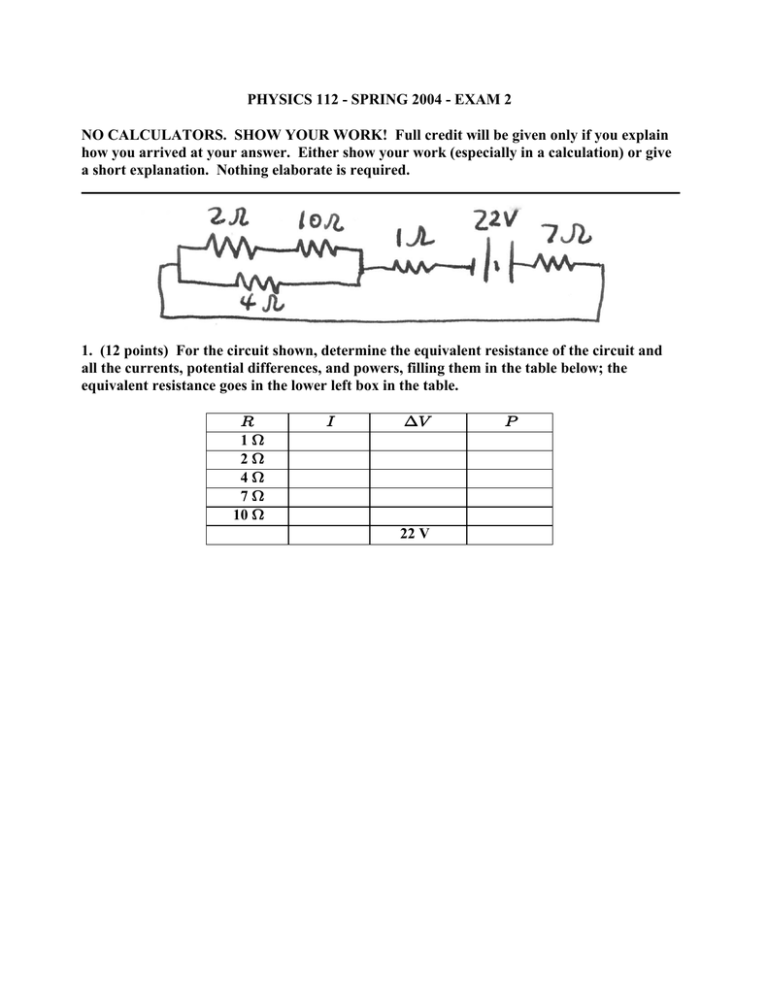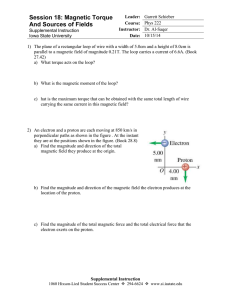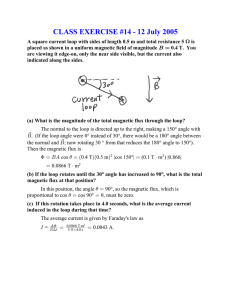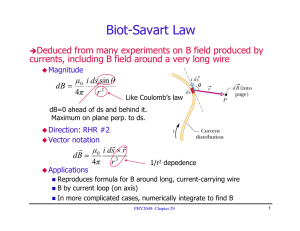PHYSICS 112 - SPRING 2004 - EXAM 2
advertisement

PHYSICS 112 - SPRING 2004 - EXAM 2 NO CALCULATORS. SHOW YOUR WORK! Full credit will be given only if you explain how you arrived at your answer. Either show your work (especially in a calculation) or give a short explanation. Nothing elaborate is required. 1. (12 points) For the circuit shown, determine the equivalent resistance of the circuit and all the currents, potential differences, and powers, filling them in the table below; the equivalent resistance goes in the lower left box in the table. V 1H 2H 4H 7H 10 H M ?Z 22 V T 2. (14 points) A circuit is shown which consists of one battery and three resistors. Only partial information is known: the current at two points, the potential at two points, and one resistance. Determine the rest of the resistances and currents, as well as the voltage of the battery, and fill out the rest of the table below (including the powers). Check your results. V 3H M 1A ?Z T t of 3. [6 points] In a certain region of space there is a uniform horizontal magnetic field F magnitude 0.20 T pointing towards the south. (a) A vertical wire 2.0 m long is carrying a current of 6.0 A in the bottom-to-top direction. Determine the magnitude and direction of the magnetic force on the wire. (b) An electrically charged object with a charge of 6 .C is moving up ( ) with a speed of @ œ 40 m/s in this region. Determine the magnitude and direction of the magnetic force on the charge. 4. (8 points) A square current loop is lying in the plane of the paper, with current as indicated. The loop lies in a uniform external magnetic field Ft directed to the left, as shown. Determine the direction of the force on each side of the current loop (indicate with arrows, or Œ ). Also show (and label) the magnetic field of the loop itself, Ft loop , in the interior of the loop (using the same symbols). Determine the net force and net torque, if any; if there is a net torque, describe how the loop will rotate as viewed along the plane of the paper from the bottom edge of the paper from the perspective of the eye shown) and through what angle the loop will rotate before the net torque on it becomes finally. Is there a net force? Is there a net torque? If so, how will the loop appear (to the eye shown) to rotate? And through what angle will it rotate? PHYSICS 112 - SPRING 2004 - EXAM 2 NO CALCULATORS. SHOW YOUR WORK! Full credit will be given only if you explain how you arrived at your answer. Either show your work (especially in a calculation) or give a short explanation. Nothing elaborate is required. 1. (12 points) For the circuit shown, determine the equivalent resistance of the circuit and all the currents, potential differences, and powers, filling them in the table below; the equivalent resistance goes in the lower left box in the table. V 1H 2H 4H 7H 10 H 11 H M 2A 0.5 A 1.5 A 2A 0.5 A 2A ?Z 2V 1V 6V 14 V 5V 22 V T 4W 0.5 W 9W 28 W 2.5 W 44 W The equivalent resistance of the parallel branch is 1/(1Î4 H 1Î(2 H 10 H) œ 3 H. The the equivalent resistance of the whole circuit is 3 H 1 H 7 H œ 11 H and the current through the battery is 22 VÎ11 H œ 2 A. From here the rest of the table can be filled out pretty quickly. 2. (14 points) A circuit is shown which consists of one battery and three resistors. Only partial information is known: the current at two points, the potential at two points, and one resistance. Determine the rest of the resistances and currents, as well as the voltage of the battery, and fill out the rest of the table below (including the powers). Check your results. V 3H 12 H 4H 6H M 4A 1A 3A 4A ?Z 12 V 12 V 12 V 24 V T 48 W 12 W 36 W 96 W The reasoning is as follows: 1. 4 A comes out of the right edge of the parallel circuit, and since one branch has 1 A the other must have 3 A. 2. The potential difference across the parallel circuit is 12 V, so the 1-A branch must have a 12-H resistor and the 3-A branch must have a 4-H resistor. 3. 4 A of current passes through the battery and the 3-H resistor, so the potential difference across the 3-H resistor is (4 A)(3 H) œ 12 V; since the right side is at 12 V the left side must be at 24 V. That means the battery must be a 24-V battery to have its positive terminal at 24 V and its negative terminal at 0 V. 4. The power can now be entered and checked. It does check out. Note that the equivalent resistance of the whole circuit is 6 H. t of 3. [6 points] In a certain region of space there is a uniform horizontal magnetic field F magnitude 0.20 T pointing towards the south. (a) A vertical wire 2.0 m long is carrying a current of 6.0 A in the bottom-to-top direction. Determine the magnitude and direction of the magnetic force on the wire. Using the right-hand rule, the magnetic force must be to the east. Its magnitude is FMP œ Ð0.20 TÑÐ6.0 AÑÐ2.0 mÑ œ 2.4 N. (b) An electrically charged object with a charge of 6 .C is moving up ( ) with a speed of @ œ 40 m/s in this region. Determine the magnitude and direction of the magnetic force on the charge. A negative charge moving up is equivalent to a current pointing down. Using the righthand rule (current down, magnetic field south) the direction of the force is to the west. The magnitude of the force is |;l@F œ | 6.C|Ð40 m/sÑÐ0.20 TÑ œ 48 .N. 4. (8 points) A square current loop is lying in the plane of the paper, with current as indicated. The loop lies in a uniform external magnetic field Ft directed to the left, as shown. Determine the direction of the force on each side of the current loop (indicate with arrows, or Œ ). Also show (and label) the magnetic field of the loop itself, Ft loop , in the interior of the loop (using the same symbols). Determine the net force and net torque, if any; if there is a net torque, describe how the loop will rotate as viewed along the plane of the paper from the bottom edge of the paper from the perspective of the eye shown) and through what angle the loop will rotate before the net torque on it becomes finally. Using the right-hand rule, we can determine that the forces on the two sides to the left are both down ( Œ ) while those on the two sides to the right are both up ( ). The magnetic field of the loop, using the right-hand rule, must be directed up ( ). Is there a net force? No, because the magnetic field is uniform. Is there a net torque? Yes. If so, how will the loop appear (to the eye shown) to rotate? The loop will rotate with the left sides going down and the right sides coming up, which would amount to a counterclockwise rotation as viewed from the vantage point of the eye shown. And through what angle will it rotate? It will rotate until the magnetic field of the loop (initially up, ) is pointed to the left, in the direction of Ft . This is a rotation of 90°.






